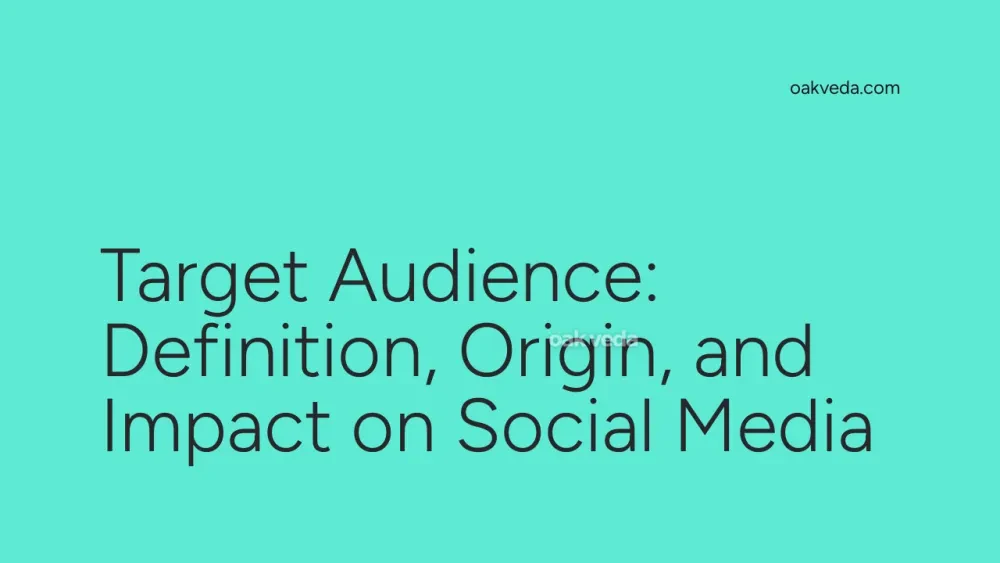
What is Target Audience?
A target audience in social media refers to the specific group of individuals or users that a brand, business, or content creator aims to reach and engage with their content, products, or services. This carefully defined demographic shares common characteristics, interests, and behaviors that align with the goals of the entity creating content or marketing on social platforms.
Origin and Development of Target Audience Concept
The concept of target audience predates social media, originating in traditional marketing and advertising. However, with the rise of digital platforms, the importance and sophistication of target audience identification have grown exponentially. Social media's data-rich environment has transformed how businesses and creators define and reach their ideal audience.
How Target Audience Works in Social Media
Identifying a target audience on social media involves analyzing various data points:
- Demographics: Age, gender, location, education, income
- Psychographics: Values, attitudes, interests, lifestyles
- Behavioral patterns: Online activities, purchasing habits, content preferences
- Platform usage: Preferred social media platforms and engagement habits
By understanding these factors, brands and creators can tailor their content, messaging, and strategies to resonate with their intended audience effectively.
Types of Target Audiences
Target audiences can be categorized in several ways:
- Primary and Secondary: The main group you're targeting vs. a secondary group that might also be interested
- Current vs. Potential: Existing customers or followers vs. those you aim to attract
- B2B or B2C: Business-to-business audiences vs. consumer-focused audiences
- Niche vs. Broad: Highly specific groups vs. wider, more general audiences
Popular Examples of Target Audience Segmentation
- Nike: Targets fitness enthusiasts and athletes across various age groups
- TikTok: Initially targeted Gen Z users but has expanded to include millennials and older demographics
- LinkedIn: Focuses on professionals and B2B audiences
- Roblox: Primarily targets children and young teenagers
Impact of Target Audience on Social Media Culture
Understanding target audiences has significantly influenced social media culture:
- Personalized Content: Platforms use algorithms to show users content based on their interests and behaviors
- Niche Communities: The rise of specialized groups and forums catering to specific interests
- Influencer Marketing: The emergence of micro and nano-influencers targeting specific audience segments
- Platform Diversification: Different social media platforms catering to various demographic groups
Controversies Surrounding Target Audience Segmentation
While targeting specific audiences can be effective, it has raised concerns:
- Privacy Issues: The collection and use of personal data for targeting purposes
- Echo Chambers: The potential for users to be exposed only to content that aligns with their existing views
- Discrimination: Concerns about excluding certain groups from seeing particular content or advertisements
- Manipulation: The potential for highly targeted content to influence user behavior and opinions
How Brands and Influencers Use Target Audience Insights
- Content Creation: Tailoring content themes, formats, and styles to audience preferences
- Platform Selection: Choosing social media platforms where the target audience is most active
- Advertising: Creating highly targeted ad campaigns to maximize ROI
- Product Development: Using audience insights to inform new product or service offerings
- Community Building: Fostering engaged communities around shared interests and values
Future Trends in Target Audience Strategies
- AI-Driven Personalization: More sophisticated use of artificial intelligence to predict and cater to individual preferences
- Cross-Platform Targeting: Unified strategies to reach audiences across multiple social media platforms
- Ethical Targeting: Increased focus on responsible and transparent audience targeting practices
- Real-Time Adaptation: Dynamic content and strategies that adjust based on real-time audience feedback and behavior
- Voice and Visual Search: Adapting targeting strategies for emerging search technologies
FAQs about Target Audience
-
Why is identifying a target audience important? Identifying a target audience helps optimize messaging, content creation, and campaign planning, leading to more effective social media strategies and better ROI.
-
How often should I reassess my target audience? It's recommended to review and update your target audience analysis regularly, at least once or twice a year, or when significant market changes occur.
-
Can a brand have multiple target audiences? Yes, many brands have multiple target audiences, often with different strategies for each segment.
-
How do I find my target audience on social media? Use platform analytics, conduct surveys, analyze competitor audiences, and leverage social listening tools to identify and understand your target audience.
-
What's the difference between a target audience and a buyer persona? A target audience is a broader group of potential customers, while a buyer persona is a detailed, fictional representation of your ideal customer within that audience.
Understanding and effectively reaching your target audience is crucial for success in the ever-evolving world of social media. By continually refining your approach and staying attuned to your audience's needs and preferences, you can create more impactful, engaging content and build stronger connections with your followers.
You may be interested in:
- Big Yikes: Definition, Origin, and Impact on Social Media
- Ok Boomer: Definition, Origin, and Cultural Impact
- Komi: Definition, Origin, and Impact on Creator Marketing
- SMB: Definition, Origin, and Impact on Social Media Marketing
- "I'm Baby": Definition, Origin, and Impact
- Tube Girl: Definition, Origin, and Impact on Social Media

